• THE POSITIVE POWER OF PLANKTON
• NO SUCH THING AS A SEAGULL?!
• MEASURE A MARINE MAMMAL
Plus, all the latest Born Free news!
SPRING 2023 ISSUE 8
Welcome to Hear The Roar!! In this issue we’re learning all about the underwater world.
“Greetings wild things! It’s time to celebrate the sea.
I’m lucky enough to live by the coast in the UK and try to swim yearround. But, what joy to return to the warm waters of Greece last summer, to visit Cephalonia – the island where, 30 years ago, I worked in turtle conservation as a young zoologist. And look who came to say hello – yes, a 30-year-old turtle, one of ‘my babies’ all grown up!

I’m so happy you love the wild as we do at Born Free. Together, let’s make the world a kinder place for people AND wildlife!”
Celia Nicholls, Editor at Born Free
Quiz Time And Fantastic Facts 18 Roar For Nature 14 Wildlife Heroes 16 Ambassador Column 17 Measure A Marine Mammal 19
contents And Finally… 20 Species Spotlight 3 Born Free News 4 Tarnya’s Corner 5 The Positive Power Of Plankton 6 Paws For Thought 8 Litter Pick For Wildlife 10 No Such Thing As A Seagull?! 12 2 welcome
© P Richardson
SPECIES SPOTLIGHT
LOGGERHEAD TURTLE
• Loggerheads are a species of marine turtle found in warm seas around the world.

• Just 5cm long when they hatch, adults grow to over 1m long, and weigh up to 170 kg – as much as a baby elephant!
• Named for their large heads, strong jaws can crunch through shells of molluscs and crabs. They also eat fish, jellyfish, sponges and seaweeds.
• Can live to the grand age of 80 years old.
• Wild turtles face many threats from humans including climate change and pollution, being hunted for food, getting tangled in fishing nets, or eating litter.
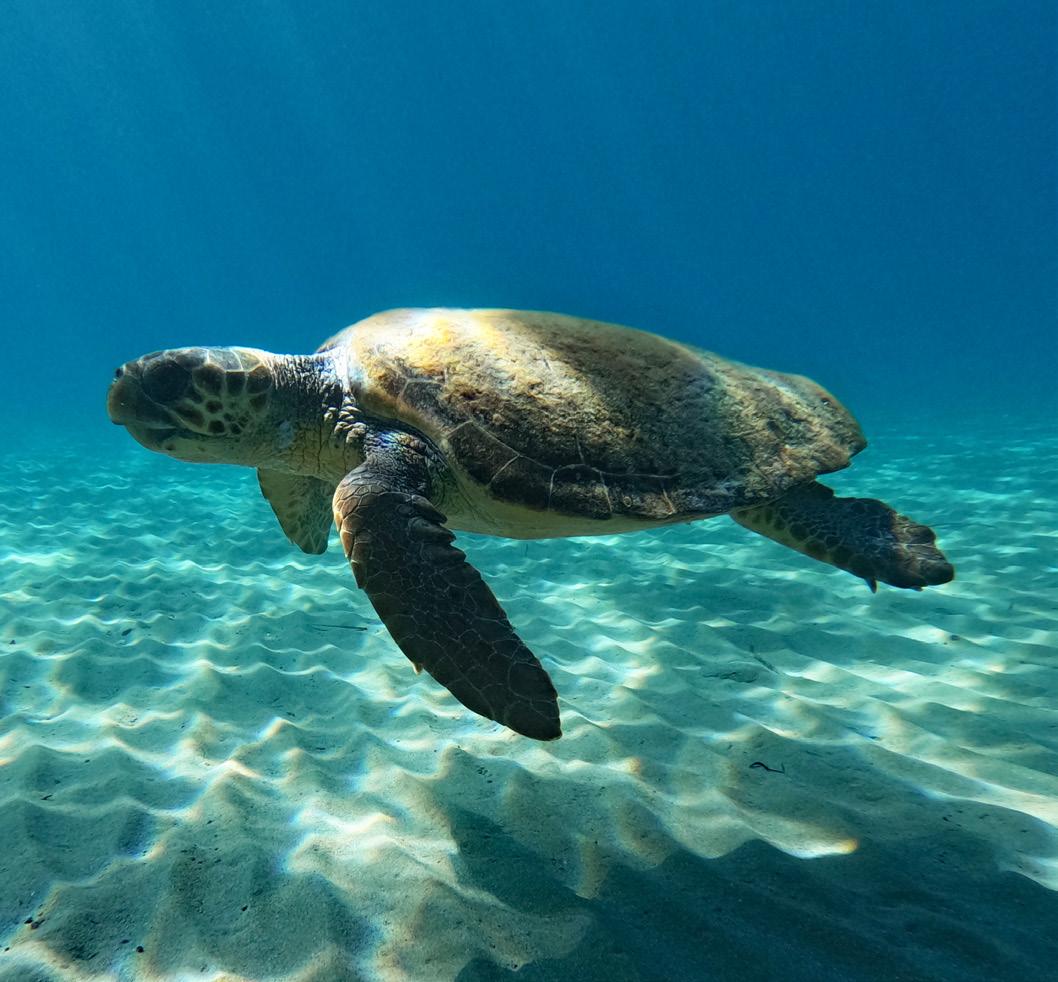
SWIMMING FREE!
For years, two loggerhead turtles Genoveffa and Gavino were held in tiny, dark and dirty tanks at an aquarium in Italy. The terrible conditions made them quite sad and ill. But, thanks to tourists reporting this to Born Free, the turtles were rescued and nursed back to health. In 2021, the pair returned to the wild. Fitted with trackers, we’re monitoring their progress, and both are flourishing in the ocean where they belong!
3
© P Briguglio
© P Richardson
BORN FREE NEWS








FIREWORKS IN ZOOS?


CARING FOR NOKU
This little, orphaned forest elephant, named Noku, was rescued in March 2022 by our friends at Elephant Research and Conservation, in Liberia. Sadly we think her mother was killed by poachers. Noku is dependent on human care, but thankfully, is now thriving. We hope one day she will return to the wild where she belongs.

The latest winner of Born Free’s McKenna-Travers conservation award is Letícia Benavalli, who won £10,000 to support her outstanding work to protect wild jaguars in Cerrado, Brazil. The Cerrado is an important savannah habitat, also home to maned wolves and giant anteaters.
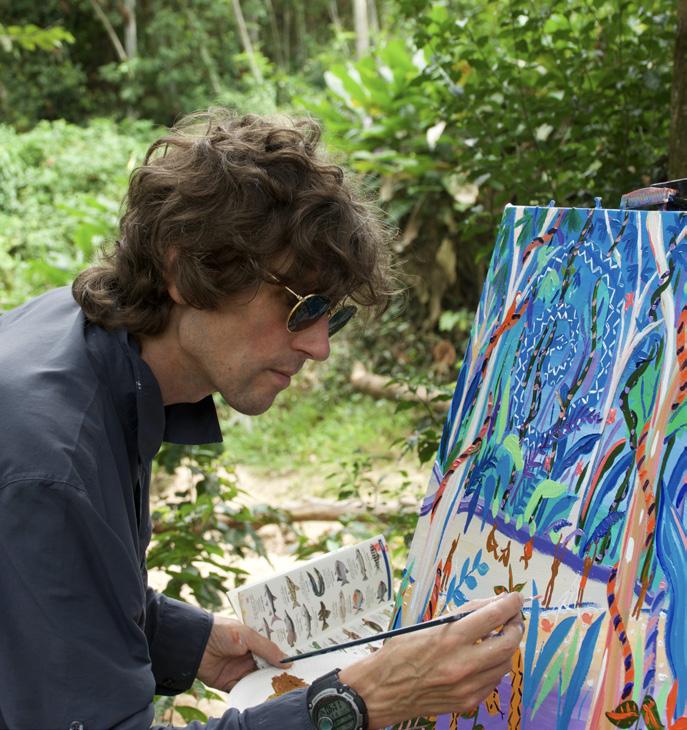
the black-naped pheasant-pigeon for the first time in 140 years after the bird appeared in camera trap images in Papua New-Guinea. What an incredible rediscovery!

4
© Stefan Schweihofer
Our Rescue and Care Coordinator, Tarnya, is always ready to help any wild animal in need!
“Gary the herring gull chick was found alone and dehydrated. With no parents in sight, and the roof top he had fallen from inaccessible, he was taken to a wildlife hospital to recover. Sometimes it’s possible to reunite herring gull chicks with their parents by simply putting them back on the roof they have fallen off –but always seek help from an adult.”
Spot the Difference!
Tortoise Turtle
What to do if you find a grounded gull chick:



• Keep an eye on the chick – it may just be learning to fly with their parents close by.


• If you’re concerned, contact your local wildlife rescue for advice.
• Never attempt to put a gull chick back on the roof yourself. This should only be done by a responsible adult.
Find out more about gulls on page 12.
Terrapin
Despite being related to one another, tortoises, turtles and terrapins are distinct in their own way. Can you spot the differences between a tortoise, turtle and terrapin?
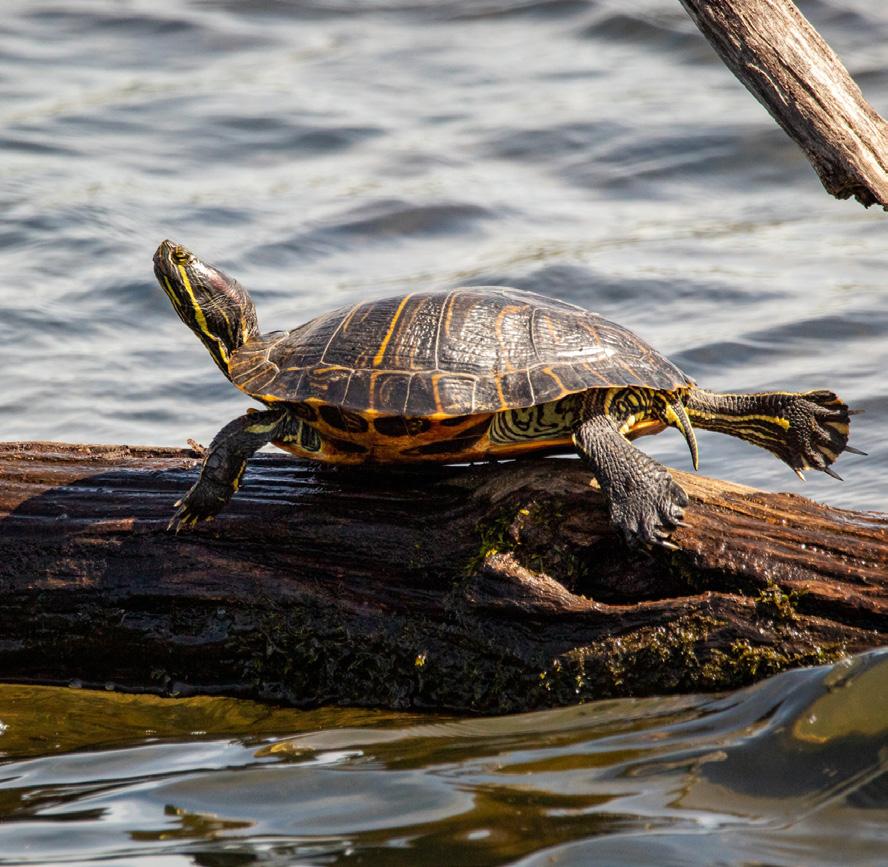


Find out the answers later in this magazine!

5
5
PLANKTON POWER OF THE POSITIVE POWER OF















The ocean is full of trillions of tiny plants and animals, known as plankton. Most of these plants and animals are so small you need a microscope to see them! Despite their size, plankton are an essential part of the ecosystem, supporting all other ocean life.

Phytoplankton

















































































































Phytoplankton is made up of lots of tiny plants. Like all plants, phytoplankton make their energy using sunlight, so they stay close to the ocean’s surface. Phytoplankton are incredibly important, producing over half of the world’s oxygen, which all other life on earth needs to breathe.







DID YOU KNOW?

Some plankton glows! Bioluminescent plankton flash brightly when disturbed. Scientists think this is to scare off or distract predators.

6
Plankton can be found in both marine and freshwater environments. Marine habitats (estuaries and the ocean) have a much higher concentration of salt than freshwater habitats (rivers and lakes). Few animals can travel between salt water and fresh water. Those that can include common eels, salmon and bull sharks.
Zooplankton

















































































































Zooplankton is made up of lots of tiny animals, as well as eggs and larvae of fish, crustaceans and jellyfish. Zooplankton feeds on phytoplankton but is itself a tasty snack for all sorts of marine predators. To keep themselves safe, zooplankton spend the day in the deep ocean, returning to the surface each night to feed.
How you can protect marine and freshwater habitats:

• Conserve water by taking shorter showers or storing rainwater to use in your garden. Using less water means there will be more left for wildlife.



































































































































































• Use less plastic and recycle more. Our waste can make its way to the ocean and harm wildlife.
• If you visit the beach on holiday, take all your litter home, and keep a respectful distance from wild animals so they aren’t disturbed.
DID YOU KNOW?
Ocean sunfish, or mola mola, can grow to over 1,000kg, but their larvae are just 2.5mm long and weigh less than 1 gram! They look like tiny little stars, drifting along with other zooplankton on the ocean current.

7
Bull shark
Sunfish Plankton images © Picturepest/ Creative Commons Franck Fauvel/ Wikimedia Commons
2.5mm
In 1969, Pole Pole, a two-year-old elephant was captured and taken from her wild herd in Kenya, to be given to London Zoo as a diplomatic gift. Born Free’s Co-Founders, Bill Travers and Virginia McKenna, did everything they could to prevent the move, but sadly she was sent to London Zoo.


At the zoo, Pole Pole was kept in a small, concrete enclosure, with two Asian elephants she didn’t always get along with. In the wild, elephants live in large, family herds, so life at the zoo must have been very stressful for her.
Pole Pole began to behave abnormally and by 1983 was often seen pacing and swaying. She had a broken tusk and lived alone, after the elephants she shared her enclosure with had died. Bill and Virginia campaigned to improve her conditions and London Zoo agreed to move her to a larger zoo with more elephants. Sadly, Pole Pole didn’t survive the move. She collapsed and died after being left standing in her travel crate for hours. She was just 17 years old –yet wild elephants can for more than 60 years.
Outraged by her death, Bill, Virginia and their son Will have dedicated their lives to speaking out for wild animals, like Pole Pole, ever since.
Thankfully, London Zoo no longer keeps elephants, but there are still over 1,000 kept in zoos across the world today, including 50 in the UK.
Do you think these intelligent, social creatures should be kept in captivity?
8
PROBLEMS FOR ELEPHANTS LIVING IN ZOOS:

• Tiny enclosures in comparison to wild habitats
• Small herds and families separated
• Average lifespans in zoos are half that of a wild elephant
• Some zoos still take elephants captured from the wild

• Many elephants show signs of mental health issues, such as repeatedly swaying or pacing.
HOW YOU CAN HELP ELEPHANTS:
• Pledge not to visit zoos, safari parks or circuses that keep elephants.
• Never ride elephants or take part in elephant trekking, washing, or buy art created by elephants on holiday.
• Tell others how amazing elephants are and why they should be kept safe in the wild.
9
© Daily Mail © Joanne McArthur/BF
Litter can cause all sort of problems for wildlife. It can blow into rivers or the ocean, animals can get tangled in it or even mistake it for food, making them ill. Holding a school litter pick can make a huge difference for wildlife, both on land and in our rivers and ocean!

Taking The Issue Further:
Create a rota for your school so every class can take turns to do a weekly litter pick in the school grounds. Learning about the issue first-hand will encourage others to make positive changes for the environment.

You Will Need:
Gloves Hi-vis jacket Litter picker



A container for litter, such as a strong bag or bucket
1. Plan where around your school you will hold you litter pick.
2. Make sure everyone uses litter pickers and appropriate gloves.
3. Put litter collected in a bag or bucket (or other appropriate container), so it doesn't blow away. If possible, sort the rubbish as you go, recycling as much as you can.

4. Photograph or keep a log of how much rubbish you collect - share this information with your school to help change attitudes towards dropping litter. You could even hold an assembly to raise awareness.
Like this activity?
You can find lots more free, fun activities and lessons on Born Free’s Education pages: www.bornfree.org.uk/teaching-resources
SEAGULL?! NO SUCH THING AS A
Gulls can be found across the world, but did you know, there’s no such thing as a ‘seagull’? The term refers to any of the 50+ species of gull on the planet (and they don’t all live by the sea). Gulls are regarded by some as pests, but we don’t think these intelligent birds deserve such a negative reputation.
Laughing Gull
Found: US, Canada, Mexico and Northern South America Habitat: Coasts, saltmarshes, rivers, farmland and rubbish dumps. The laughing gull is named because their call sounds like a shrill laugh.

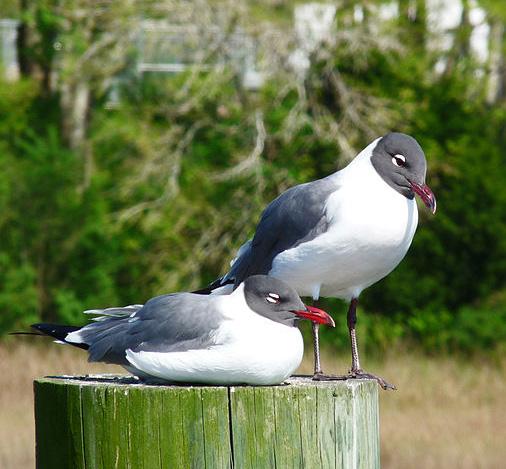
NORTH AMERICA
Lava Gull
Found: Galapagos Islands
Habitat: Coasts, rocky shorelines and sandy beaches. The lava gull is the rarest gull in the world, possibly totalling as few as 300 individuals.

SOUTH AMERICA
Grey-Headed Gull
Found: Western Africa, South Africa, Madagascar and parts of South America
Habitat: Coasts, estuaries, reedbeds and marshes.
Like other marsh-breeding gulls, grey-headed gulls can create floating nests in which to lay eggs.
12
Jacques Nyemb/ Wikimedia Commons
Andrew Morffew/ Creative Commons
European Herring Gull
Found: Northwest Europe
Habitat: Coasts, lakes, rivers, towns and rubbish dumps. A herring gull in France was spotted using bread to bait fish while eating none of the bread itself – this is tool use and a sign of great intelligence.
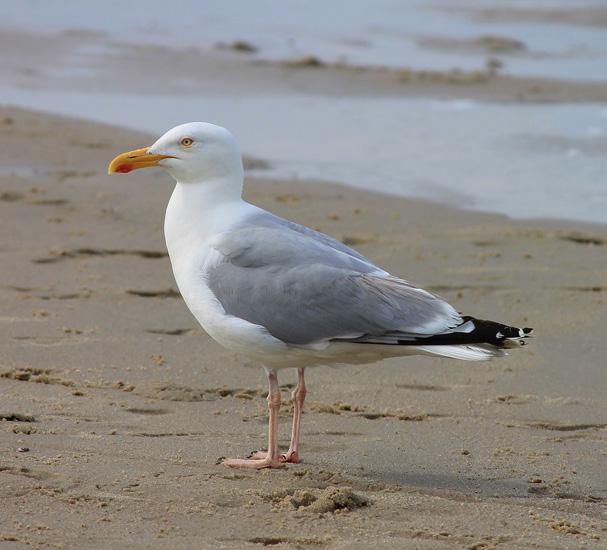
DID YOU KNOW?
The oldest recorded herring gull in the wild was at least 29 years and 3 months old.
The Gull Project
In 2021, Scottish-based company Humane Wildlife Solutions, managed to change Scottish law to save the lives of gull chicks. Now vulnerable chicks and eggs can be taken to wildlife rehabilitation centres to be reared and released. Since the change in law, over 300 gulls have been released from centres in Scotland, whose nests would have otherwise been destroyed.
AFRICA
EUROPE ASIA
Black Headed Gull
Found: Europe, Asia, Africa and Eastern Canada
Habitat: Coasts, wetlands and farmland. Black-headed gulls can secretly put one of their own eggs into another couple’s nest, leaving the other gull pair to rear the chick instead.
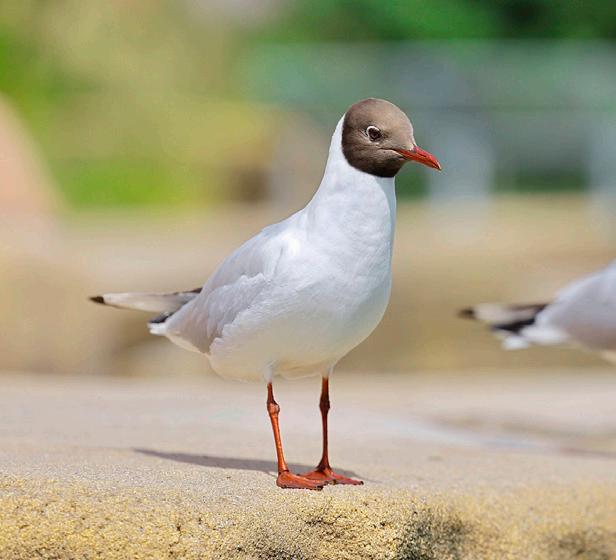
DID YOU KNOW?
Gulls are very intelligent and adaptable, which is why many species have moved into our towns and cities, where our messy habits mean there’s plenty of food!
AUSTRALIA
DID YOU KNOW?
Gull species breed on every continent, even Antarctica!
13
FOR NATURE ROAR A R
Cora, aged 10
Cora loves wildlife. Through her adoptions of the Jaguar Family, Rhino Family and Parly the moon bear she has donated £108 to Born Free. Cora also wrote her own song about the importance of caring for wild animals and making sure they remain living wild and free.

Here’s an extract from Cora’s song: If we don’t wake up and learn to love We’ll lose this precious gift of the wild No it doesn’t take a lot to see There only one way to be and that’s free Born free, forever free.
Roy, aged 13
Roy has worked really hard to create habitats for wildlife and to let others know why they are so important. “In our school, I have planted ten trees and encouraged 20 people to plant trees in their homes, because trees are homes and food for animals.”

14
Abraham, aged 11
Abraham stood up for his local forest habitat. “I was walking around the forest after school and came across people cutting trees. I asked them why they were doing this and politely told them that they are destroying animal homes, and this could create an imbalance in the ecosystem.”


Liliwen, aged 7
Liliwen loves learning about wildlife! She regularly attends Born Free’s education webinars. “I think learning about wildlife is fascinating. I particularly enjoy leaning about their unique characteristics and their habitats. It is important to learn about wildlife and the environment so we can all live happily.” During our most recent webinar about giraffes, Liliwen created this beautiful artwork!

WHAT A SUPERSTAR!
Evans, aged 10
Upon seeing an elephant at a local farm, Evans sprang into action to keep both the community and elephant safe. “I told my father who called Kenya Wildlife Service Officers. I could hear people making lots of noise to scare the elephant away. Some were throwing stones at it. I gathered courage and told them that animals need our protection, and we should not hurt them, but call the Kenya Wildlife Service Officers to steer them away from our farms.”
Tell us about what you’ve been up to for wildlife. Send your stories and pictures to education@bornfree.org.uk (please ask your parent or guardian before getting in touch).
For fundraising ideas visit: www.bornfree.org.uk/education-fundraising

15
Wildlife Heroes Wildlife Heroes
DID YOU KNOW?
Orca are the largest member of the dolphin family.
Since 1994, Born Free has been working with OrcaLab, a whale and dolphin research station on Hanson Island on the west coast of Canada, operated by our Wildilfe Heroes, Helena Symonds and Dr Paul Spong.

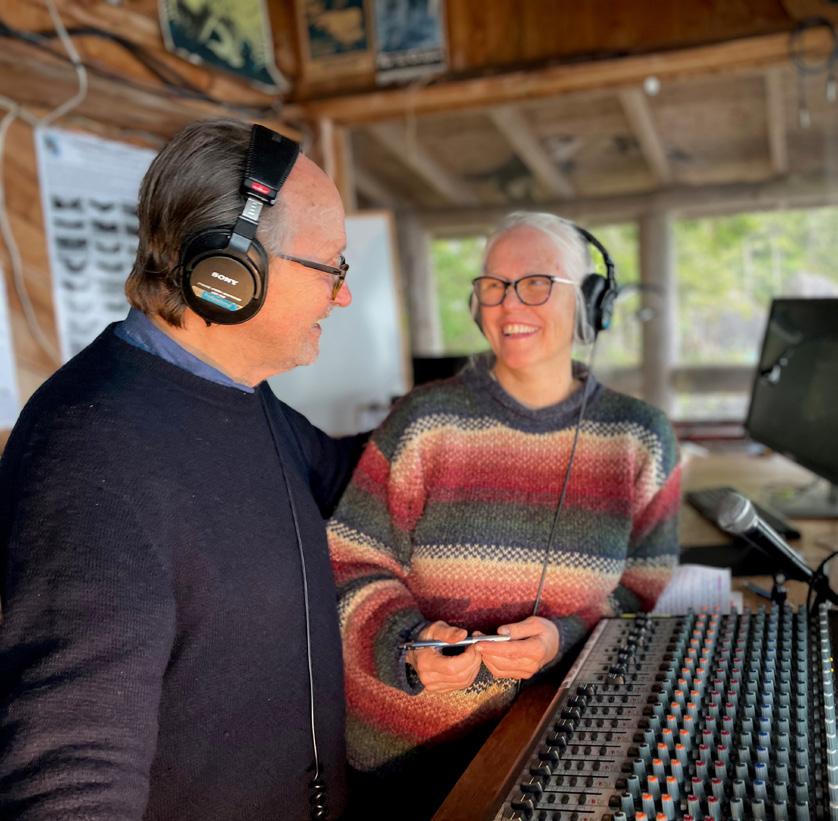
“As you might guess we mainly study orcas. However, humpbacks, minke whales, dolphins and porpoises also get our attention as they are frequent visitors too.
“We have been learning about these species for a very long time - over 50 years! We really respect whales and do not want to interfere with their lives, so instead of following them around in noisy boats we use hydrophones (underwater microphones) and remote cameras placed in different locations and listen and watch them from our Lab.
“A deeply moving experience was when we helped the lost two-year-old orphaned orca, named Springer, reunite with her family, with Born Free’s help. Twenty years later she is all grown up with two babies of her own!
“Springer’s life would have been very different had she been taken into captivity and forced into a life without her ocean home and family. Corky, Springer’s cousin, has suffered this fate for many, many years. We want to help Corky come home too.”
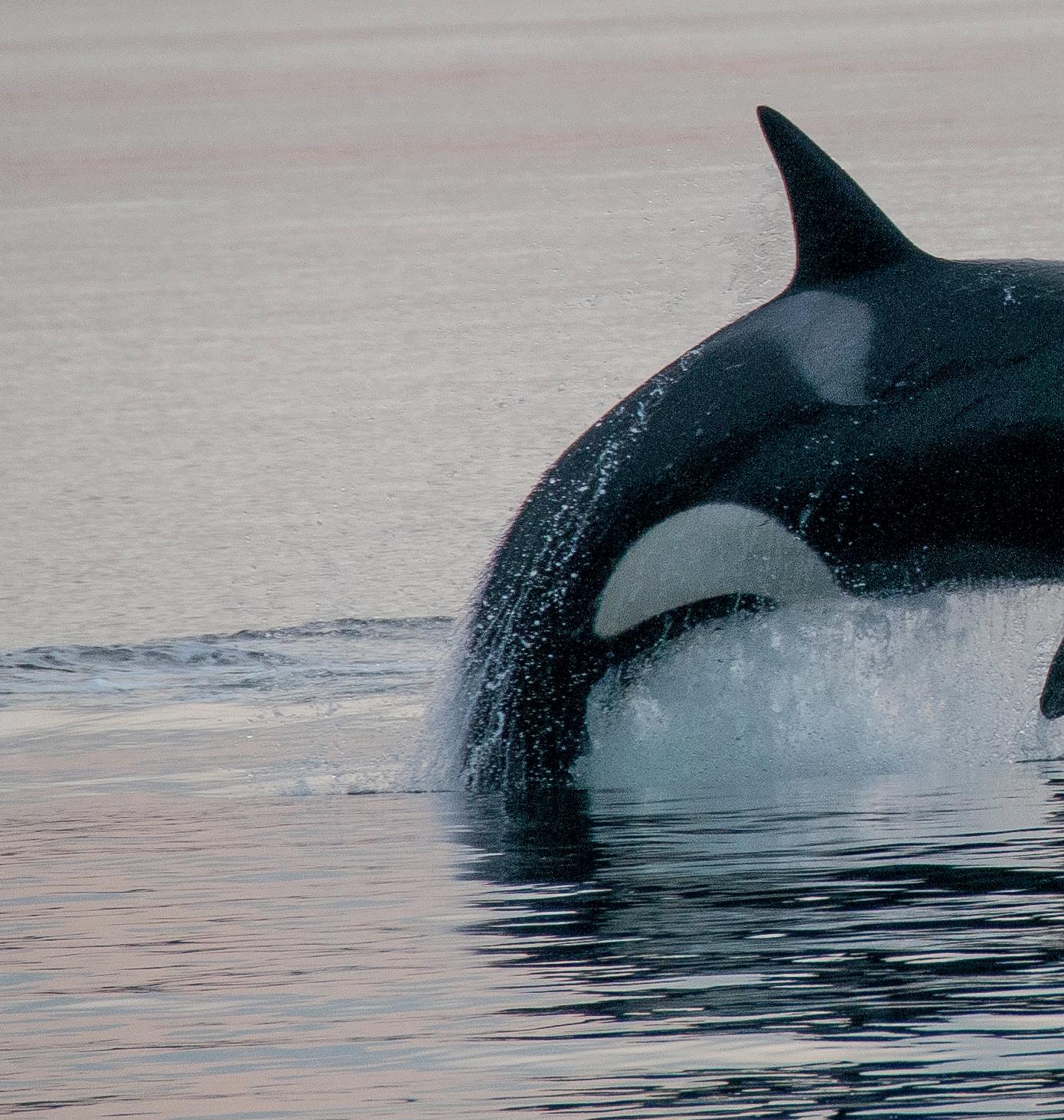
16
OrcaLab
DID YOU KNOW?
Orca live similar lives to elephants. They are long-lived and live in close-knit families led by an older female called the matriarch.

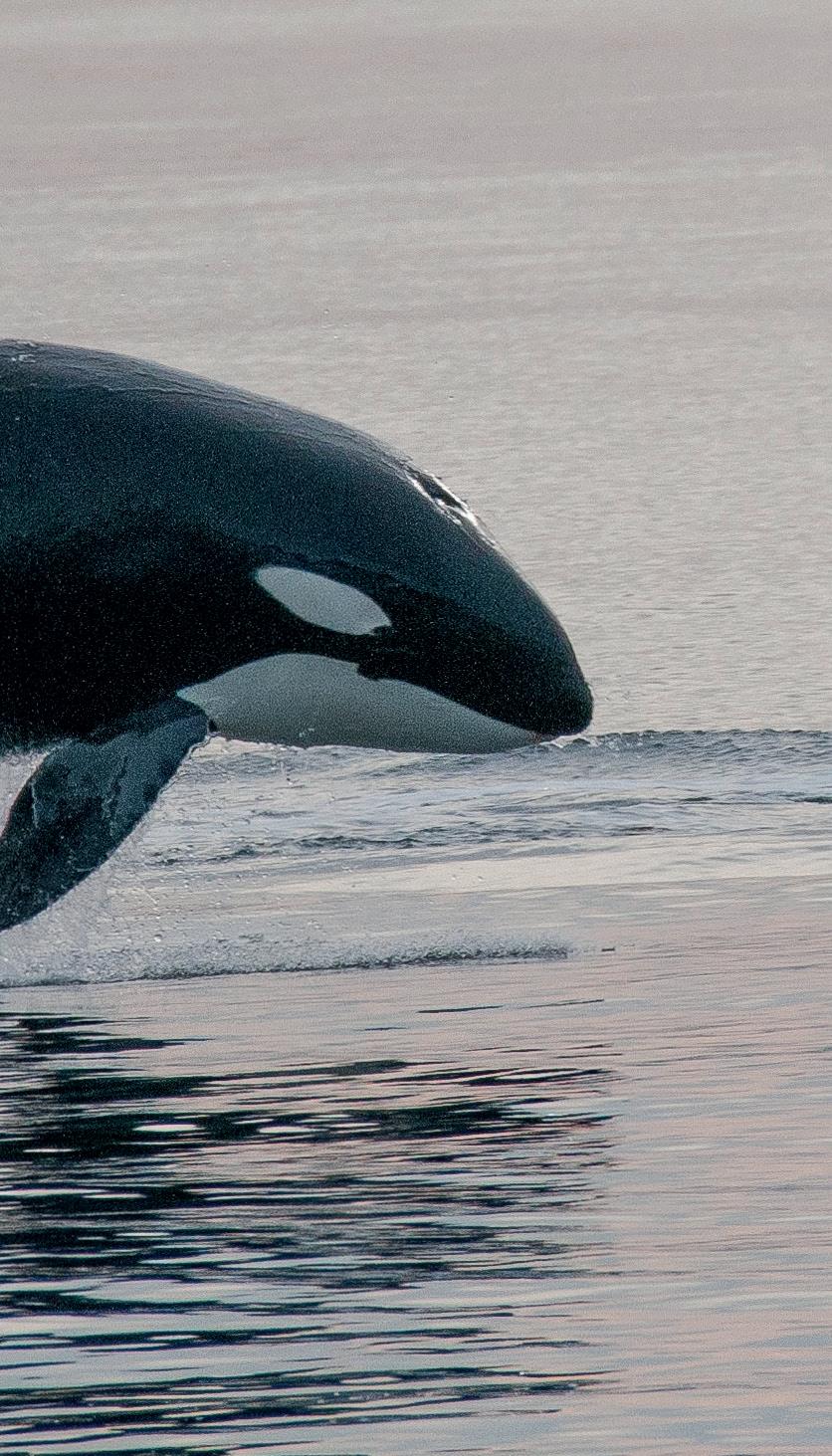
AMBASSADOR COLUMN
See if you can catch a glimpse of dolphins, whales or sea lions visiting OrcaLab’slivestream cameras: explore.org/ livecams/orcas
Recently, we caught up with Born Free USA’s Youth Ambassador and founder of Kids Can Save Animals, Kate Gilman Williams.

“My earliest memory of wildlife was when I first landed at a lodge in Africa. I was seven years old. I looked out the window of the airplane and a giant, majestic giraffe was standing on the runway!
Springer
Read more about Springer’s story in Issue 2 of Hear the Roar!! bornfree.org.uk/publications/ hear-the-roar-issue-2
“My time in Africa inspired me to write a book with my safari guide, Michelle Campbell. Our book tells kids that humans are the biggest threat to wildlife and to wild spaces. Today, I focus on three ways kids and teenagers can become an animal advocate: through music, technology, and by raising our voices.
“Remember - don’t visit any place that uses animals for human entertainment. Every wild animal deserves to live wild and free.”
17
© David Howitt
© Jared Towers
QuiztimeQuiztime
1
HOW BIG IS AN OCEAN SUNFISH LARVAE?
A. 0.25mm
B. 2.5mm
C. 25cm
4
HIPPOS ARE CLOSELY RELATED TO...

A. ...whales
B. …elephants
C. …manatees
2
HOW HEAVY CAN AN ADULT LOGGERHEAD TURTLE GET?
A. As heavy as a pygmy goat
B. As heavy as a Labrador dog
C. As heavy as a baby elephant
APPROXIMATELY HOW MUCH OF THE EARTH’S OXYGEN DOES PHYTOPLANKTON PRODUCE?
HINT: ALL QUIZ ANSWERS CAN BE FOUND IN THIS MAGAZINE
LAVA GULLS ARE ONLY FOUND... 3
A. …in the Channel Islands
B. …in the Galapagos Islands
C. …in the Solomon Islands
6
SUPER SPEEDY
Atlantic bluefin tuna are the largest species of tuna, reaching up to 4m long. Perfectly streamlined, they reach speeds of up to 43mph.

Leopard seal
WHICH IS THE LARGEST SPECIES OF TUNA?
A. Atlantic bluefin tuna
B. Bigeye tuna
C. Skipjack tuna
FAMILY TREE
Dugongs and hippos might look rather similar, but their family trees are very different! Dugongs are more closely related to elephants but spend their entire lives in the ocean. Hippos are more closely related to whales but are found in freshwater lakes and rivers across Africa.
WHAT BIG TEETH YOU HAVE!
Leopard seals have teeth longer than an African lion. These long teeth help them catch their favourite food – penguins!

Dugong
Hippo

5 A. 1/4 B. 1/3 C. 1/2
facts
18
Fantastic
Julien Willem/ Wikimedia Commons
Working in small groups, first draw around one person lying down using chalk, you could even ask your teacher if you can draw round them as well. This will help show how big marine mammals are compared to humans!
Next measure out the length of the first marine mammal. You’ll need to work together so you’re accurate. Once measured, draw your marine mammal outline.
Continue the process until you have measured and drawn out all the mammals. Some of your drawings might overlap with other group’s drawings, but that’s ok. You can use different coloured chalk to make things less confusing.
When you’re done, compare the sizes of your marine mammals!
Tortoise
Large, often domed shells
Turtle
Legs
You Will Need:
Chalk


Metre sticks or measuring wheel
Mammals to measure:
Harbour porpoise - 1.9m long
Dugong – 2.6m long
Risso’s dolphin – 3.8m long
Orca – 9.8m long
Humpback whale – 17m long
Did you spot the differences between tortoises, turtles and terrapins?

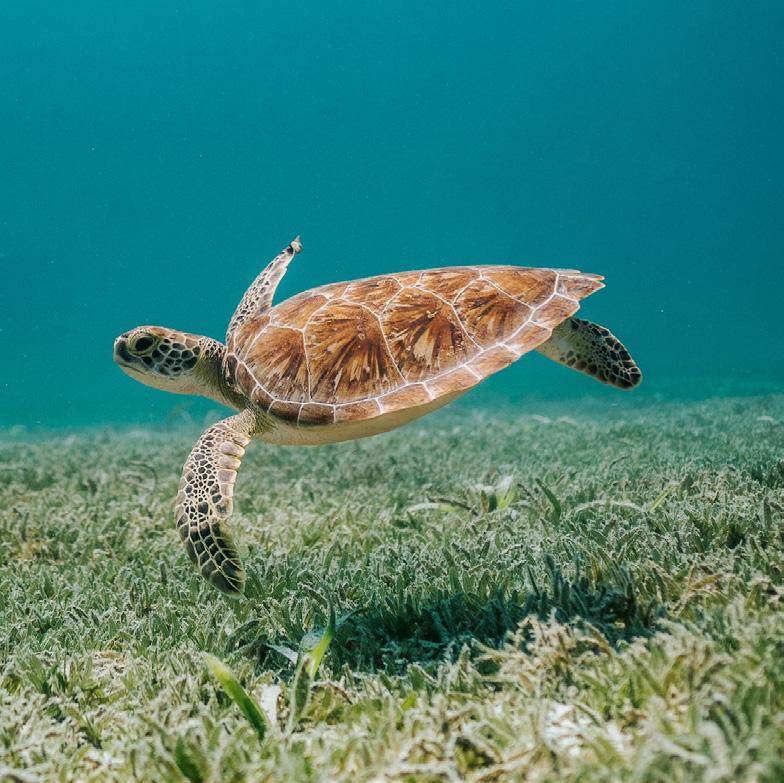

Live in the ocean
Only return to land to lay eggs
Terrapin

Flatter shells than tortoises
Legs, with paddle-like feet for swimming Claws
Spend their time between freshwater and land
Streamlined shells
Claws
Spend their whole lives on land
Flippers
QUIZ ANSWERS
A great activity for you and your friends to carry out in the playground!
1. B 2.5mm 2. C As heavy as a baby elephant 3. B …in the Galapagos Islands 4. A …whales 5. C ½ 6. A Atlantic bluefin tuna
19
…a special thank you.
In September 2022, we received a call from the Director of Kolobo Primary School in Ethiopia. Yeabsera Endale, one of our Environment Club members, had brought him a female leopard tortoise in need of rescue.
Meskerem, as she has been named, is now safely at Ensessa Kotteh, Born Free’s Wildlife Rescue, Conservation and Education Centre, and, after some quarantine and a good check-up, she has joined the other tortoises we care for.

Sadly, her shell is broken, so she will not be able to live life in the wild, but we can offer her the best lifetime care possible.
Well done Yeabsera!
Born Free is an international wildlife charity devoted to wild animal welfare and Compassionate Conservation. Born Free works to end captive exploitation and Keep Wildlife in the Wild, where it belongs! Printed on recycled paper The views expressed in Hear the Roar!! are not necessarily those of Born Free. Born Free Foundation, 2nd Floor, Frazer House, 14 Carfax, Horsham, West Sussex, RH12 1ER www.bornfree.org.uk +44 (0) 1403 240170 General enquiries: info@bornfree.org.uk Education enquiries: education@bornfree.org.uk AND GO GREEN WITH OUR ONLINE MAGAZINE! View, download and share our paper-free electronic version at: www.bornfree.org.uk/publications And
Registered Charity No: 1070906
finally…




















































































































































































































































































